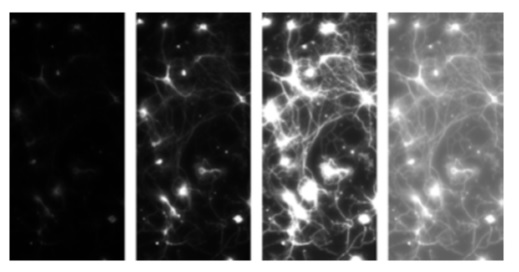
Overview of Dynamic Range and Fluorescence Microscopy
Dynamic Range (Knowledge Base, 2019)
Dynamic range refers to contrast at various intensities. As light level
decreases, the signal level of the image decreases and the noise ratio
increases. As we saw above, this reduces contrast. Likewise, increasing
brightness can overdrive the detector also reducing contrast. The range
from dark to bright at which acceptable contrast can be achieved is the
dynamic range.
Most people can discern about 256 levels of brightness, so an 8-bit
dynamic range is acceptable for image analysis by humans. However, to the
degree that machines can analyze to greater than 8 bits, more information
can be extracted from the image. This characteristic can yield some
interesting results.
We saw in the section about focus and depth of field that it is
possible to acquire a series of images at varying focal lengths and blend
them together to obtain an image that was in focus across the entire range.
What if a similar result could be achieved with a range from very dark to
very bright? It turns out it can.
Figure 8 illustrates a series of raw images acquired at various camera
gain settings. In the first image, only the brightest areas are visible.
In the second image, the gain is increased and more detail is visible. In
the third image, dimmer areas are visible but bright areas are over
exposed. The fourth image is the result of the previous three. The
obvious tradeoff here is that contrast is sacrificed for accuracy and that
additional filtering is to be performed by the machine vision software